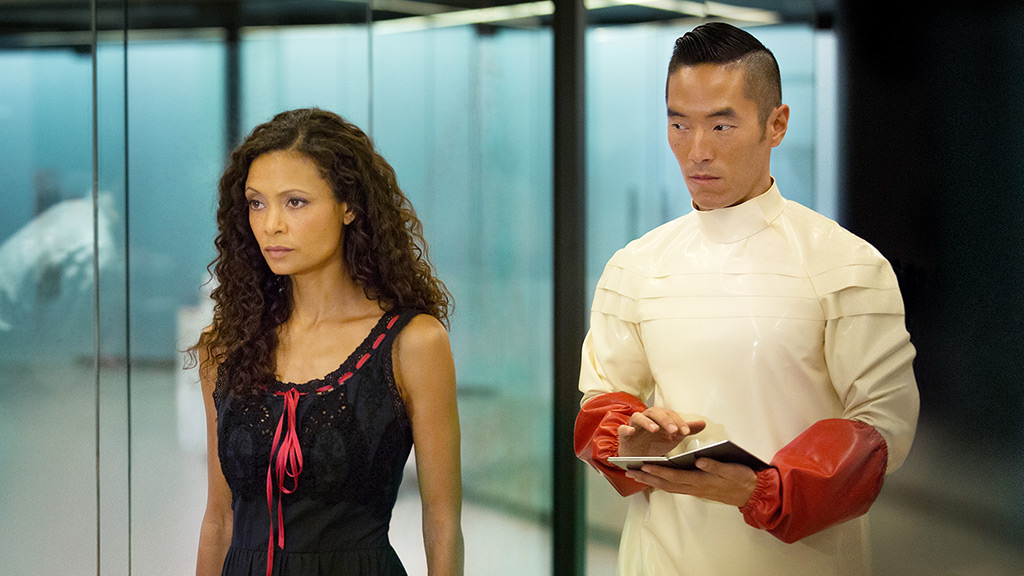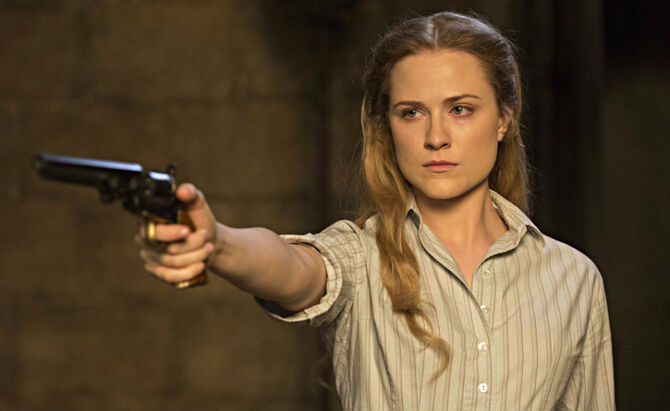By John Tan
This paper aims to explore the notion of masculinity and femininity in reference to the American Television Series, Westworld (2016). The premise of the show revolves around a theme park, called Westworld where humans (guests) are allowed to indulge their human appetite without having any consequences, no matter how moral or corrupt. To fulfill the objective, the creators of park invented hosts (human-like robots) who solely exist for the entertainment of the guests. This means the hosts are programme to not question the nature of their existence/reality. Thus, their characteristics remain constant. The rationale for analysing this TV series is to prove that the concept of masculinity and femininity is a social construct. In order to demonstrate the following point, a detailed analysis will be made on the portrayal of gender in this TV series.
This paper aims to explore the notion of masculinity and femininity in reference to the American Television Series, Westworld (2016). The premise of the show revolves around a theme park, called Westworld where humans (guests) are allowed to indulge their human appetite without having any consequences, no matter how moral or corrupt. To fulfill the objective, the creators of park invented hosts (human-like robots) who solely exist for the entertainment of the guests. This means the hosts are programme to not question the nature of their existence/reality. Thus, their characteristics remain constant. The rationale for analysing this TV series is to prove that the concept of masculinity and femininity is a social construct. In order to demonstrate the following point, a detailed analysis will be made on the portrayal of gender in this TV series.
In his book What is Social Construction? (2001),
Boghossian defines the term social construct. The author refers the term to an
idea or belief that solely exist due to the contingent aspects of our social
selves. This means the idea or belief wouldn’t have existed if we didn’t create
it and if there was no need for it in the first place. At least not in its
present form if we had decided to mold it differently. In contrast to
naturally existing objects, they were created without the interference of humankind. As Ian Hacking notes in his monograph, The Social Construction of What? (1999), the talk surrounding
social construction isn’t exclusive to worldly items such as things, kinds, and
facts but also to our beliefs about them.
The concept of
masculinity and femininity, in general, is about the set of attitudes, roles,
social norms, and the hierarchy of values that are expected of each male and female
in every society. Nevertheless, there are multiple interpretations of it.
Il’inykh S.A., (2012: Online). Spence JT (1984) offers two levels of
interpretations of masculinity and femininity. The first meaning focuses on the
labels used to identify specific objects, events, or qualities that are
associated with males or females in a given culture. Whereas, the second
definition is used in the context of constructing a fundamental property or aspect
of the individual’s self-concept that is not visually obvious. This means
masculinity and femininity are referred to as bipolar opposites and these implicit
assumptions function to conclude his or her position on the hypothetical
masculinity-femininity continuum.
Nick Drydakis,
Katerina Sidiropoulou, Swetketu Patnaik et al (2017, pg. 2-3) elaborates on these implicit traits that are assigned to both genders. Masculinity refers to
characteristics such as being physically strong, technically competent,
ambitious, self-sufficient, authoritative, and in control of your emotions.
Conversely, femininity is associated with characteristics such as empathy,
sensitivity, loyalty, and a caring deposition. These following attributes act as
binary opposites, women appear to lack the qualities that men possess and
vice versa (Heilman, 2012). For example, men are allowed to be dominant whereas
women are encouraged to be submissive. In contrast, women are allowed to be
vulnerable but men are not permitted to display weaknesses. (Rudman et al,
2008)
In relation to
the chosen television series, Westworld,
the thesis statement is reflected when gender normativity is assigned and
portrayed by the following characters. In the show, the cyborgs are
automatically assigned with a gender in mind and are created to illustrate a
specific version of masculinity and femininity. For instance, the character
Hector Escaton symbolizes the “ideal” version of masculinity. Following Spence
JT’s (1984) interpretation, the usage of labels is demonstrated in the
positioning of Hector Escaton. As an example, the character is often dressed in
black, seen using a gun, smoking, indulging in alcohol, and is even designed
with a scar on his face to prove that he is experienced with physical combats.
This all works to prove his masculinity. In terms of his attributes, Hector possesses
“masculine” attributes such as being physically strong, technically competent,
ambitious, self-sufficient and authoritative.
However,
characters like Lee Sizemore and Felix Lutz indirectly rebuts the notion of
masculinity. The two following characters presented qualities that lean towards
femininity. Lee Sizemore, the narrative director of Westworld created Hector to
embody the person he wished he was. In fact, it was shown several times that
Lee remembers Hector’s speech regiment and his way of handling things. Yet,
Lee’s personality does not mirror Hector’s characteristics. In the second
season, Lee finds himself in many challenging situations yet he is unable to
defend himself and only relies on others to rescue him.


As for the
latter, his character earns the audiences’ sympathy because he shows a lot of
passiveness. For illustration, he doesn’t stand up for himself when he is faced
with mockery and insults, and only appears to submit to them. Also, he doesn’t
question instructions and only abides by them. In addition to the
aforementioned characters, the character evolution of Dolores also earns the
thesis statement some truth. The narrative that was assigned to the main
character, Dolores Abernathy is conventional as it mirrors the traditional
characteristics that are expected of a white female. During the genesis of the
show, Dolores portrayed stereotypical feminine traits. As an example, Dolores
was emphatic, sensitive, loyal, passive, naïve, and had a caring and gentle
deposition.
Here Dolores not
only uploads the values of regular femininity but also white femininity. In
this context, I refer white femininity to the attributes that revolve around
the all-American girlhood ideal. In Forever
Adolescence: Taylor Swift, Eroticized Innocence, and Performing Normativity, Valerie
Pollock (2014) explores the myth of the all-American girlhood, noting that it
directly connects to the beliefs of what is expected of a white female. White
femininity is tied to the beliefs in “appropriate” whiteness, uploading passivity, purity, sexual innocence and heterosexuality.
Nonetheless, as
the show progressed, Dolores begins questioning and understanding the nature of
her existence. Leading her to come upon a realization;
“Those are all just roles you forced me to play. Under
all these lives I’ve lived something else has been growing. I’ve evolved into
something new. And now I have one last role to play. Myself.”

In the ending of
season 1 and the entirety of season 2, Dolores challenges the script that was
assigned to her by creating a whole new persona for herself. She begins
adopting stereotypical masculinity traits into her system. For example, Dolores
became physically strong, ambitious, self-sufficient, authoritative and in
control of her emotions and thoughts.
Aside from the hosts, the performance of gender normativity is also explored with the guests. At the beginning of the series, it was stated that the purpose of the park is for self-identification and exploration. This means the guests are allowed to be any version of themselves without having any consequences. A prime example would be the character Willaim. The character first arrives at the park reluctantly with his brother-in-law. Initially, the character showed a personality that leans towards a 'feminine' temperament.
However, over
the course of time, William experienced a change in nature. To give an example,
William initially struggled to stand up to his brother-in-law and his slurs.
But the more roles he played in the park, the more he realized that his brother-in-law is a “weakling”. Due to this, he finally stood up to him and this won
him the family power struggle. This victory eventually led him to develop an
interest in the narratives that are offered in the park. Nonetheless, it was
later revealed that his wife Juliet committed suicide. To cope with the grief,
William made frequent visits to Westworld in hopes of finding fulfillment again.
In more specificity, William spent 30 years finding for the “maze” as he
believes that the true mystery of the park resides there.
In conclusion,
the character evolution and portrayal of these following characters prove that
the concept of masculinity and femininity is a social construct. Their
transformation and depiction act an indication to prove that no individual regardless
of their gender is one dimensional as the notion of masculinity and femininity expects
males and females to be. Hence, if cyborgs are even able to question and
challenge the qualities expected of them, what else us humans?
References
Boghossian, Paul (2001) What is Social Construction? Times
Literary Supplement.
Drydakis, N., Sidiropoulou, K., Patnaik,
S., Selmanovic, S., Bozani, V. (2017) ‘Masculinity vs Feminine Personality
Traits and Women’s Employment Outcomes in Britain: A Field Experiment’, p.2-3
Hacking, Ian (1999) The Social Construction of What? Cambridge. Harvard University
Press.
Heilman, M.E. (2012) Gender Stereotypes and
Workplace Bias. Research in
Organizational Behavior, Vol.32, p.113-135.
Il’inykh S.A. (2012) Masculinity and femininity: interpretation in terms of the gender
theory [online] Available from: https://research-journal.org/en/2012-en/issue-october-2012/masculinity-and-femininity-interpretation-in-terms-of-the-gender-theory/
[accessed 30/11/2018]
Pollock, V. (2014) ’Forever Adolescence: Taylor Swift, Eroticized
Innocence, and Performing Normativity’,
p.42-45
Rudman, L.A and Phelan, J.E. (2008)
Backlash Effects for Disconfirming Gender Stereotypes in Organizations. In A.P.
Brief, and B.M. Staw, (Eds.), Research in
Organizational Behaviour (4:61-79). New York, Elsevier.
Spence, JT (1984) ‘Gender identity and its
implications for the concepts of masculinity and femininity’, Nebr Symp Motiv.
1984; 32:59-95
Westworld (2016-2018). HBO Entertainment.









0 comments:
Feel free to comment and dont forget to subscribe ;)